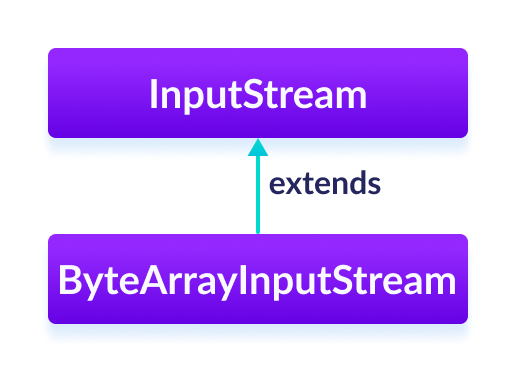The ByteArrayInputStream class of the java.io package can be used to read an array of input data (in bytes).
It extends the InputStream abstract class.

Note: In ByteArrayInputStream, the input stream is created using the array of bytes. It includes an internal array to store data of that particular byte array.
Create a ByteArrayInputStream
In order to create a byte array input stream, we must import the java.io.ByteArrayInputStream package first. Once we import the package, here is how we can create an input stream.
// Creates a ByteArrayInputStream that reads entire array
ByteArrayInputStream input = new ByteArrayInputStream(byte[] arr);
Here, we have created an input stream that reads entire data from the arr array. However, we can also create the input stream that reads only some data from the array.
// Creates a ByteArrayInputStream that reads a portion of array
ByteArrayInputStream input = new ByteArrayInputStream(byte[] arr, int start, int length);
Here the input stream reads the number of bytes equal to length from the array starting from the start position.
Methods of ByteArrayInputStream
The ByteArrayInputStream class provides implementations for different methods present in the InputStream class.
read() Method
read()- reads the single byte from the array present in the input streamread(byte[] array)- reads bytes from the input stream and stores in the specified arrayread(byte[] array, int start, int length)- reads the number of bytes equal to length from the stream and stores in the specified array starting from the position start
Example: ByteArrayInputStream to read data
import java.io.ByteArrayInputStream;
public class Main {
public static void main(String[] args) {
// Creates an array of byte
byte[] array = {1, 2, 3, 4};
try {
ByteArrayInputStream input = new ByteArrayInputStream(array);
System.out.print("The bytes read from the input stream: ");
for(int i= 0; i < array.length; i++) {
// Reads the bytes
int data = input.read();
System.out.print(data + ", ");
}
input.close();
}
catch(Exception e) {
e.getStackTrace();
}
}
}
Output
The bytes read from the input stream: 1, 2, 3, 4,
In the above example, we have created a byte array input stream named input.
ByteArrayInputStream input = new ByteArrayInputStream(array);
Here, the input stream includes all the data from the specified array. To read data from the input stream, we have used the read() method.
available() Method
To get the number of available bytes in the input stream, we can use the available() method. For example,
import java.io.ByteArrayInputStream;
public class Main {
public static void main(String args[]) {
// Creates an array of bytes
byte[] array = { 1, 2, 3, 4 };
try {
ByteArrayInputStream input = new ByteArrayInputStream(array);
// Returns the available number of bytes
System.out.println("Available bytes at the beginning: " + input.available());
// Reads 2 bytes from the input stream
input.read();
input.read();
// Returns the available number of bytes
System.out.println("Available bytes at the end: " + input.available());
input.close();
}
catch (Exception e) {
e.getStackTrace();
}
}
}
Output
Available bytes at the beginning: 4 Available bytes at the end: 2
In the above example,
- We have used the
available()method to check the number of available bytes in the input stream. - We have then used the
read()method 2 times to read 2 bytes from the input stream. - Now, after reading the 2 bytes, we have checked the available bytes. This time the available bytes decreased by 2.
skip() Method
To discard and skip the specified number of bytes, we can use the skip() method. For example,
import java.io.ByteArrayInputStream;
public class Main {
public static void main(String args[]) {
// Create an array of bytes
byte[] array = { 1, 2, 3, 4 };
try {
ByteArrayInputStream input = new ByteArrayInputStream(array);
// Using the skip() method
input.skip(2);
System.out.print("Input stream after skipping 2 bytes: ");
int data = input.read();
while (data != -1) {
System.out.print(data + ", ");
data = input.read();
}
// close() method
input.close();
}
catch (Exception e) {
e.getStackTrace();
}
}
}
Output
Input stream after skipping 2 bytes: 3, 4,
In the above example, we have used the skip() method to skip 2 bytes of data from the input stream. Hence 1 and 2 are not read from the input stream.
close() Method
To close the input stream, we can use the close() method.
However, the close() method has no effect in ByteArrayInputStream class. We can use the methods of this class even after the close() method is called.
Other Methods Of ByteArrayInputStream
| Methods | Descriptions |
|---|---|
finalize() |
ensures that the close() method is called |
mark() |
marks the position in input stream up to which data has been read |
reset() |
returns the control to the point in the input stream where the mark was set |
markSupported() |
checks if the input stream supports mark() and reset() |
To learn more, visit Java ByteArrayInputStream (official Java documentation).